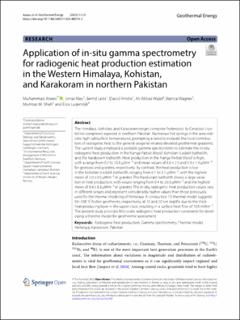| dc.contributor.author | Anees, Muhammad | |
| dc.contributor.author | Kley, Jonas | |
| dc.contributor.author | Leiss, Bernd | |
| dc.contributor.author | Hindle, David | |
| dc.contributor.author | Wajid, Ali Abbas | |
| dc.contributor.author | Wagner, Bianca | |
| dc.contributor.author | Shah, Mumtaz M. | |
| dc.contributor.author | Luijendijk, Elco | |
| dc.date.accessioned | 2024-03-25T13:46:39Z | |
| dc.date.available | 2024-03-25T13:46:39Z | |
| dc.date.created | 2023-11-14T13:38:42Z | |
| dc.date.issued | 2023 | |
| dc.identifier.issn | 2195-9706 | |
| dc.identifier.uri | https://hdl.handle.net/11250/3124115 | |
| dc.description.abstract | The Himalaya, Kohistan, and Karakoram ranges comprise Proterozoic to Cenozoic crystalline complexes exposed in northern Pakistan. Numerous hot springs in the area indicate high subsurface temperatures, prompting a need to evaluate the local contribution of radiogenic heat to the general orogenic-related elevated geothermal gradients. The current study employed a portable gamma spectrometer to estimate the in-situ radiogenic heat production in the Nanga Parbat Massif, Kohistan–Ladakh batholith, and the Karakoram batholith. Heat production in the Nanga Parbat Massif is high, with a range from 0.2 to 10.8 µWm−3 and mean values of 4.6 ± 2.5 and 5.9 ± 1.9 µWm−3 for gneisses and granites, respectively. By contrast, the heat production is low in the Kohistan–Ladakh batholith, ranging from 0.1 to 3.1 µWm−3, with the highest mean of 2.0 ± 0.5 µWm−3 in granites. The Karakoram batholith shows a large variation in heat production, with values ranging from 0.4 to 20.3 µWm−3 and the highest mean of 8.4 ± 8.3 µWm−3 in granites. The in-situ radiogenic heat production values vary in different ranges and represent considerably higher values than those previously used for the thermal modeling of Himalaya. A conductive 1D thermal model suggests 93–108 °C hotter geotherms, respectively, at 10 and 20 km depths due to the thick heat-producing layer in the upper crust, resulting in a surface heat flow of 103 mWm−2. The present study provides first-order radiogenic heat production constraints for developing a thermal model for geothermal assessment. | en_US |
| dc.language.iso | eng | en_US |
| dc.publisher | Springer | en_US |
| dc.rights | Navngivelse 4.0 Internasjonal | * |
| dc.rights.uri | http://creativecommons.org/licenses/by/4.0/deed.no | * |
| dc.title | Application of in-situ gamma spectrometry for radiogenic heat production estimation in the Western Himalaya, Kohistan, and Karakoram in northern Pakistan | en_US |
| dc.type | Journal article | en_US |
| dc.type | Peer reviewed | en_US |
| dc.description.version | publishedVersion | en_US |
| dc.rights.holder | Copyright 2023 The Author(s) | en_US |
| dc.source.articlenumber | 29 | en_US |
| cristin.ispublished | true | |
| cristin.fulltext | original | |
| cristin.qualitycode | 1 | |
| dc.identifier.doi | 10.1186/s40517-023-00273-3 | |
| dc.identifier.cristin | 2196509 | |
| dc.source.journal | Geothermal Energy | en_US |
| dc.identifier.citation | Geothermal Energy. 2023, 11 (1), 29. | en_US |
| dc.source.volume | 11 | en_US |
| dc.source.issue | 1 | en_US |

